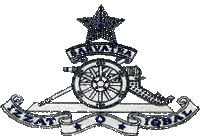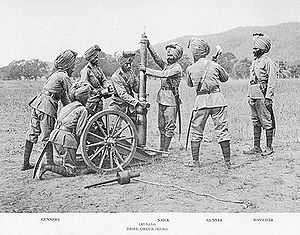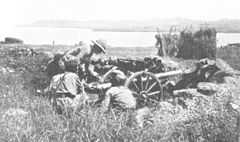Regiment of Artillery
| Regiment of Artillery | |
|---|---|
 | |
| Active | 1827- Present |
| Country | India |
| Allegiance | Indian Army |
| Type | Artillery |
| Garrison/HQ | Nashik, Maharashtra |
| Motto | Sarvatra Izzat-o-Iqbal (Everywhere with Honour and Glory) |
| Anniversaries | September 28 (Gunners' Day) |
| Decorations |
Victoria Cross 1 Vir Chakra 3 Yudh Seva Medal (YSM)1 Sena Medal 19 Shaurya Chakra 1 [1] |
| Insignia | |
| Regimental insignia | A gun with Star of India above it |
The Regiment of Artillery is an operational arm (a regiment/corps) of the Indian Army. Formerly part of Royal Indian Artillery (RIA) of British Indian Army which itself traces its origins to the formation of Bombay Artillery in 1827. It was later involved in extensive service in the First World War, in East Africa, Gallipoli, Mesopotamia and Palestine .
Today it is the second largest arm of the Indian Army, and with its guns, mortars, rocket launchers, unmanned aerial vehicles, surveillance systems, missiles and artillery firepower it constitutes almost one-sixth of its total strength.
History
Historically Mughal Emperor Babur is popularly credited with introduction of Artillery in India, in the Battle of Panipat in 1526, where he decisively used gunpowder firearms and field artillery and defeated the much larger army of Ibrahim Lodhi, the ruler of the large North Indian Delhi Sultanate, thus not just laying the foundation of the Mughal Empire but also setting a precedent of all future battles in the subcontinent. However evidence of earlier use of gun by Bahmani Kings in the 'Battle of Adoni' in 1368 and King Mohammed Shah of Gujarat in fifteenth century have been recorded.
The East India Company raised the first regular company of Artillery in 1748, with a small percentage of Indian Gunners called Gun Lashkars, Tindals and Serangs. A few Indian mountain artillery batteries, officered by the British, were raised in the 19th century and formed part of the Royal Artillery.[2] The Royal Indian Artillery (RIA) of the British India Army, was raised on September 28, 1827, as a part of the Bombay Army, a presidency army of the Bombay Presidency. It was later renamed as 5 Bombay Mountain Battery, and participated in the First Anglo-Afghan War (1839–1842). The Indian Rebellion of 1857 was sparked off in Meerut on 10 May 1857, primarily by native artillery of Bengal Army, following which all Indian artillery units were banned except mountain artillery batteries,[3] though Major Richard Keatinge of Bombay Artillery was awarded the Victoria Cross in 1858 for his service during the Indian Rebellion.

In the 20th century, the Artillery was later involved in extensive service in the First World War, in East Africa, Gallipoli, Mesopotamia, and Palestine.[2]
The Regiment of Artillery was raised on 15 January 1935, when the first three Indian Field Regiments, originally numbered A, B, and C were authorised.[4] Originally called the 'Indian Regiment of Artillery', which later became 'The Regiment of Indian Artillery' on 1 November 1940 and 'Royal Regiment of Indian Artillery' in October 1945, after its success in World War II.[3]
After the partition of India in 1947 RIA was divided between the newly formed artillery regiments of India and Pakistan.[2] In the coming years the artillery took part in all the operations fought by the Indian Army, the latest being the Kargil War.
The School of Artillery of the Indian Army is situated at Devlali near Nashik, and the Regiment of Artillery Museum, established in 1970, is also situated in Nashik at Nasik Road Camp.
The Regiment of Artillery was divided in the mid-1990s between the Field Artillery, the Corps of Air Defence Artillery formed in January 1994, and the Army Aviation Corps formed in November 1993.[5] The Field Artillery is the largest successor branch, with 190 regiments, but no longer accounted for a sixth of the army's 1.2 million 1996 strength.
Jane's Defence Weekly said in 1996 that divisional artillery deployed on India's plains is expected to have a mix of 130mm and 155mm guns.[6] This could be a combination of three 130mm regiments and one regiment of 155mm guns, or two regiments of each calibre, depending on the anticipated threat and whether the division is to be employed for offensive or defensive operations.
On 15 January 1985, a commemorative stamp depicting a Gunner and Howitzer from Mountain Battery was released by India Post, on the Golden Jubilee of the Regiment of Artillery[7]
Artillery of India

- Mortars
- 120 mm E1 light mortar
- Anti-aircraft guns
- All Weather Air Defence Gun System (AWADGS)
- 40mm Bofors L/70 anti-aircraft gun (upgraded variant)
- 40mm Bofors L/60 anti-aircraft gun (upgraded variant)
- 23mm ZSU-23-2 anti-aircraft gun
- Field artillery
- 105mm Indian Field Gun
- 105mm Light Field Gun
- 122mm D-30 Howitzer
- 130mm M-46 Field Gun
- 155mm E1 Metamorphosis gun 45 Caliber Howitzer
- 155mm Haubits FH77/B Howitzer
- Self-propelled artillery
- Rocket artillery
- 122mm BM-21 Grad Multiple Barrel Rocket Launcher
- 214mm Pinaka Multi Barrel Rocket Launcher
- 300mm BM-30 Smerch Multiple Barrel Rocket Launcher
Notable personnel

- Chief of Army Staff of the Indian Army
- General Paramasiva Prabhakar Kumaramangalam (June 7, 1966 - June 7, 1969)
- General Om Prakash Malhotra (May 31, 1978 - May 31, 1981)
- General Sunith Francis Rodrigues (June 30, 1990 - June 30, 1993)
- General Sundararajan Padmanabhan (September 30, 2000 - December 31, 2002)
- General Deepak Kapoor (September 30, 2007 - March 31, 2010)
- Umrao Singh: Victoria Cross:World War II.
Further reading
- History of the Regiment of Artillery, Indian Army, by Y. B. Gulati, D. K. Palit. Published by Leo Cooper, 1972. ISBN 0-85052-118-1.
- Kargil '99: Blood, Guts and Firepower, by Gurmeet Kanwal, India Army. Regiment of Artillery. Published by Regiment of Artillery in association with Lancer Publishers, 2000. ISBN 1-897829-64-7.
References
- ↑ Regiment of Artillery - Honours and Awards Indian Army website.
- ↑ 2.0 2.1 2.2 History of Artillery, Indian Army.
- ↑ 3.0 3.1 Regiment of Artillery Global Security
- ↑ Indian Field Artillery in World War II
- ↑ Sawhney, Jane's Defence Weekly, 9 October 1996, p.35
- ↑ Pravin Sawhney, 'India's artillery a force in its own right,' Jane's Defence Weekly, 9 October 1996, p.35-37
- ↑ 15th Jan 1985 Stamp India Post.
External links
| Wikimedia Commons has media related to Artillery of India. |
- Regiment of Artillery at Official website of the Indian Army
- Martyrs of Regiment of Artillery Indian Army
- Regiment of Artillery at Bharat Rakshak
- WeGunners
- 4 Hazara Mountain Battery (FF)
| ||||||||||||||||||||
| ||||||||||||||
